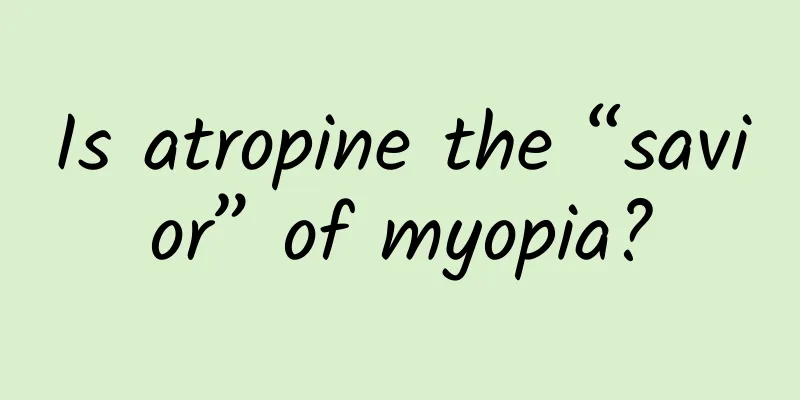Is atropine the “savior” of myopia?

|
Before the summer vacation, the teacher gave Duoduo’s mother a “Notice of Poor Vision”. Duoduo, a third-grade student, has a vision of 4.7 in his left eye and 4.8 in his right eye. Duoduo's mother was very anxious! During the epidemic last year, her child took a lot of online classes, which required the use of mobile phones and tablets. The schoolwork was heavy, and the child did not like sports and only liked to stay at home and read. In order to prevent the child from myopia, the mother stared at the child's writing posture every day, urged the child to go out for exercise, and nagged the child to rest early. Unexpectedly, the child's eyesight still declined. My neighbor Jiajia's mother told Duoduo's mother that she heard that atropine can be used to treat myopia, so she decided to give it a try. What is atropine? Can it really treat myopia? What is atropine? There are many clinical methods for treating myopia in children. For example, wearing fully corrected optical glasses and contact lenses, using atropine eye drops and pirenzepine eye drops locally, and increasing outdoor activity time. Although using frame glasses can control myopia to a certain extent, it cannot prevent myopia from getting worse; orthokeratology lenses are expensive and cannot be widely promoted; and atropine is currently a clinically effective drug for alleviating myopia progression at home and abroad. Atropine is a white crystalline alkaloid extracted from belladonna and other Solanaceae plants. It is a non-selective M cholinergic receptor antagonist with a potent and long-lasting ciliary muscle paralysis. Atropine is actually very common, especially when performing mydriasis eye examination. The 1% atropine eye drops commonly used in clinical practice are mainly used for mydriasis and iridocyclitis treatment before fundus examination and refractive examination of optometry. Can atropine treat myopia? In 2005, the Singapore Eye Research Institute (SERI) published the results of the ATOM 1 clinical study in the American Academy of Ophthalmology journal, proposing the potential role of atropine eye drops in the treatment of myopia. Its ATOM 2 clinical study showed that the efficacy of atropine in controlling myopia is positively correlated with its concentration, that is, the higher the atropine concentration, the better the effect of controlling myopia development, but the drug-induced adverse reactions such as photophobia and near vision blur are also more obvious, and the degree of myopia may rebound after discontinuation. High concentrations of atropine are not effective, so researchers have begun to explore the use of low concentrations of atropine to control myopia. The results show that the use of 0.01% atropine maintains a relatively good myopia control effect, while the side effects of ciliary muscle paralysis, pupil dilation, and rebound after discontinuation are much smaller than the use of high concentrations of atropine. From the perspective of long-term effects, regular use of 0.01% atropine eye drops for local eye drops has good effectiveness and safety in alleviating and controlling the occurrence and progression of myopia in children, correcting refraction, and slowing the growth of myopia. It is also easier for children and parents to adhere to treatment. In 2019, the National Health Commission clearly stated in the "Guidelines for Appropriate Technology for the Prevention and Control of Myopia in Children and Adolescents" that low-density atropine eye drops can effectively delay the progression of myopia. It should be pointed out that there is also a lack of response to treatment with low-concentration atropine, that is, some children do not respond after using it. Can everyone use low-concentration atropine? Low-concentration atropine eye drops are not suitable for everyone, and should not be abused blindly. The use of atropine to control myopia has certain individual selectivity and should be used after a doctor's evaluation. In May 2020, at a press conference on scientific eye use to prevent myopia held by the Joint Prevention and Control Mechanism of the State Council, experts stated that low-concentration atropine eye drops are not a miracle drug. Some children will experience photophobia, blurred vision at close range, and atropine allergic reactions after using low-concentration atropine; some children even used 0.01% atropine eye drops, which could not effectively control the progression of myopia. Therefore, do not rely solely on eye drops to prevent and control myopia. Experts say that reducing close-up eye use, paying attention to eye posture, and increasing outdoor exercise are the most important ways to prevent and control myopia. At the same time, you should go to the hospital for a health check early to monitor the occurrence and development of myopia and intervene in time. To delay the development of myopia, you should also pay attention to the following points: 1. Increasing the time spent outdoors has a clear protective effect on preventing the occurrence and development of myopia in adolescents. Go outdoors more often in sunny weather. 2. Parents should remind their children to take breaks when supervising them to study hard; every 45 minutes of study, they should look into the distance for 10 minutes. 3. Children with myopia will suffer from eye fatigue if they do not wear glasses. Although children's ciliary muscles have strong adjustment ability, if they are always in a spasmodic state, eye fatigue will only accelerate the decline of vision and deepen myopia. Author: Li Haiyan, Deputy Director and Pharmacist of the Pharmacy Department of Xi'an Fourth Hospital Review expert: Xue Xiaorong, deputy director and pharmacist of the Pharmacy Department of Xi'an Fourth Hospital He Meifeng, deputy director and pharmacist of Hainan Eye Hospital |
<<: Early screening makes gastric cancer have nowhere to escape!
Recommend
Popular Science | How can elderly people with swallowing dysfunction eat safely? Keep these 5 tips in mind
"Unchewable rice cakes", "unswallo...
What should I do if I have pimples inside my pubic hair?
Today's society is developing rapidly, and pe...
What should I eat when I have menstrual pain?
Menstruation is a normal physiological phenomenon...
Why does muscle weakness occur?
Is it harder than before to get up from a chair, ...
A little bleeding during pregnancy
If you have a little vaginal bleeding during preg...
What kind of tea should women drink to replenish blood and qi?
It is very necessary for female friends to replen...
What does the disappearance of leucorrhea mean?
During the period of preparing for pregnancy, wom...
Remedies for getting caught in the rain during menstruation
There is more rain in the summer. If you are not ...
TikTo growth slows down? Meta is using the same method it used to kill Snap to kill TikTok
Meta counterattacks TikTok, is Reels grabbing mar...
As the temperature gradually warms up in spring, blood pressure drops. Can people with high blood pressure stop taking antihypertensive drugs?
Several people with high blood pressure asked Hua...
How to treat mild kidney stones?
Kidney stones are not unfamiliar to us, and many ...
What to do about vaginal itching?
For the majority of female friends, vaginitis is ...
How to treat cervical nabothian cyst
Cervical nabothian cyst is also called gynecologi...
How many days after cesarean section did the second child get discharged from the hospital?
For normal women, giving birth to their first chi...
What are the characteristics of a woman's pregnancy?
Generally, pregnant women also have some obvious ...





![[Medical Q&A] Can hyperbaric oxygen therapy improve sleep quality?](/upload/images/67effbbfd6526.webp)



